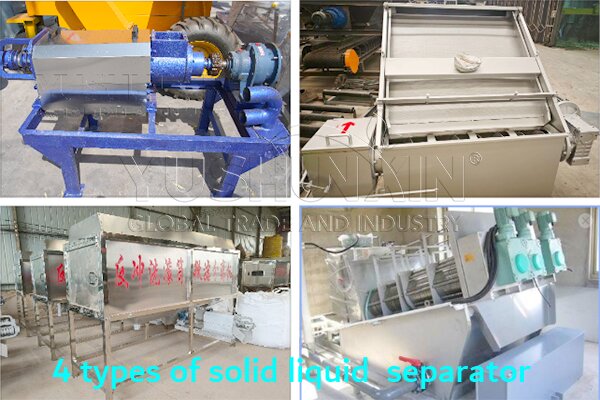1. Why Solid-Liquid Separation Matters in Fertilizer Preparation
Before any liquid fertilizer production process begins, one of the most important steps is managing the raw materials — especially when they come from livestock manure, biogas slurry, or food waste.
These materials contain high moisture and suspended solids that can clog pipelines, slow fermentation, and affect nutrient balance.
That’s where the solid-liquid separator (also known as a manure dewatering machine or liquid-solid separating system) becomes essential. It ensures that the raw liquid feed is clean, balanced, and ready for efficient fertilizer processing.
2. Common Types of Solid-Liquid Separators
In modern liquid fertilizer manufacturing lines, several types of dewatering machines are used depending on material properties and processing goals:
- Screw press separator – uses a helical screw to press out liquid, suitable for chicken manure, pig slurry, and digested residues.
- Inclined screen separator – ideal for light, watery waste such as biogas slurry or vegetable residues.
- Rotary drum dehydrator – rotates continuously to filter larger solids while keeping maintenance simple.
- Multi-disc screw press – combines compression and filtration for high-capacity, energy-efficient operation.
Each solid-liquid separation machine has unique advantages in handling moisture content and improving the efficiency of downstream equipment like fermentation tanks and mixing systems. Learn more!

3. How It Improves Liquid Fertilizer Quality
Using a manure dewatering system not only reduces the overall water content of raw materials but also helps control the carbon-to-nitrogen ratio, which is crucial for microbial growth during fermentation.
In the liquid biofertilizer preparation process, clearer liquid means:
- Faster fermentation and more stable microbial activity.
- Reduced sediment during storage.
- Better consistency in nutrient concentration.
This step directly affects the quality and shelf life of the final liquid organic fertilizer product.
4. Practical Considerations for Users
When selecting a solid-liquid separation unit for a liquid fertilizer plant, users usually compare:
- Material compatibility — stainless steel for corrosive biogas slurry, carbon steel for general use.
- Processing capacity — matched with daily manure or slurry output.
- Maintenance and spare parts availability — critical for long-term, continuous operation.
For most medium-sized liquid biofertilizer plants, the separator is often the first key piece of equipment in the production line, setting the foundation for stable and efficient fertilizer production.
Conclusion
A solid-liquid separator may seem like a small part of the system, but it plays a huge role in determining the success of liquid fertilizer manufacturing. By ensuring cleaner, well-balanced raw materials, producers can achieve higher efficiency, better fertilizer quality, and lower operational costs — making every drop of organic waste count toward sustainable agriculture. If you need the manure-solid dewatering machine, welcome to visit: https://www.liquidfertilizerplants.com/products/solid-liquid-separator/
